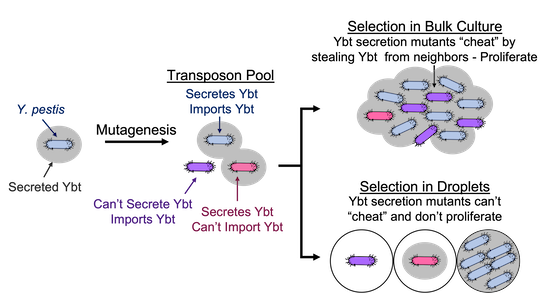New Paper on the Yersiniabactin Secretion System
JULY 28, 2023
In a paper published today in EMBO reports, Sarah Price describes the use of a novel droplet Tn-Seq approach in collaboration with Dr. Tim van Opijnen to identify the primary secretion mechanism for yersiniabactin in Y. pestis.
Yersiniabactin (Ybt) was discovered 30 years ago and is a secreted metallophore used by a variety of bacteria to acquire metals during infection. Ybt is an essential virulence factor for Y. pestis. While the enzymes needed for the synthesis of Ybt and the proteins involved in the import of Ybt once bound to metals have been well described, the machinery needed for Ybt export from the bacterium has eluded researchers for three decades.
The reasons this machinery was not identified earlier are two-fold. First, the genes are not part of the Ybt genetic locus. Second, because Ybt is secreted, conventional mutagenesis approaches like TnSeq are not viable discovery approaches due to bacterial “cheating”. Why?
Essentially, although Ybt secretion mutants can’t secrete Ybt, they can cheat by stealing Ybt from their neighbors, and thus will not have fitness defects during selection.
However, Dr. van Opijnen and colleagues developed a form of TnSeq called Droplet TnSeq (dTnSeq). dTnSeq overcomes Ybt cheating by using microfluidics to separate individual Tn mutants into their own lipid-encapsulated droplets to prevent Ybt diffusion.
Using dTnSeq, we found two mutants with fitness defects. Sarah went on to show that these genes were part of an operon encoding an AcrAB-TolC efflux system, which was required for in vitro growth in metal-limited media and for the secretion of Ybt in Y. pestis.
However, the AcrAB-TolC mutant was only partially attenuated during plague infection, indicating that a secondary system is present in Y. pestis that can partially compensate for the loss of AcrAB-TolC secretion of Ybt (a project for our next student!).
We are extra excited by this discovery because we think this mechanism will be conserved in other gram negatives, including important MDR strains, and is a druggable target for novel anti-virulence therapeutics.
Thanks to all who helped on this project, including Drs. Bob Perry, Thomas Kehl-Fie, and Sylvie Garneau-Tsodikova, and special thanks to Dr. Ralph Isberg for introducing us to Tim to start this collaboration!



